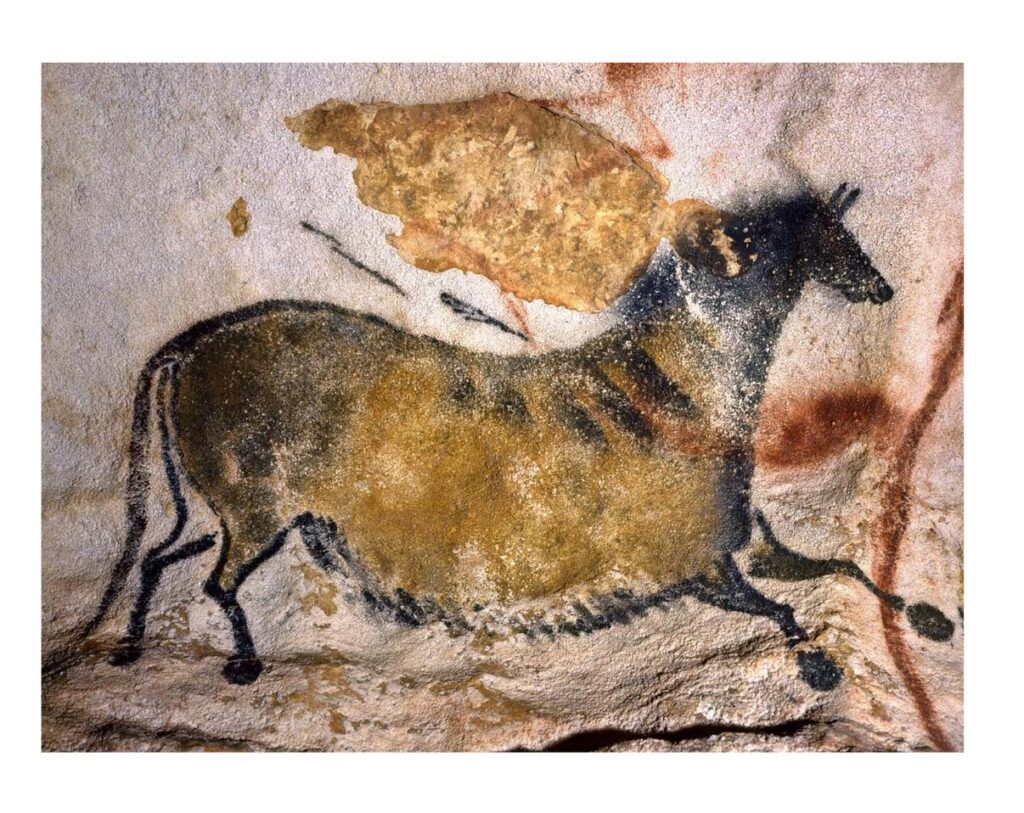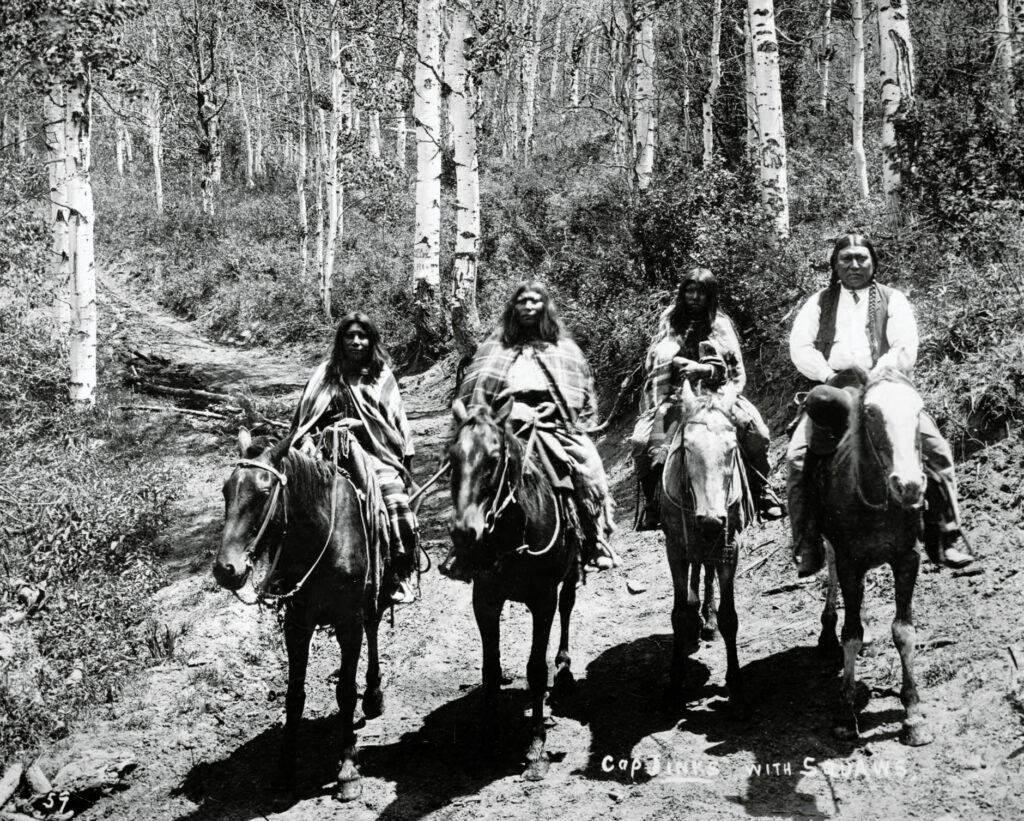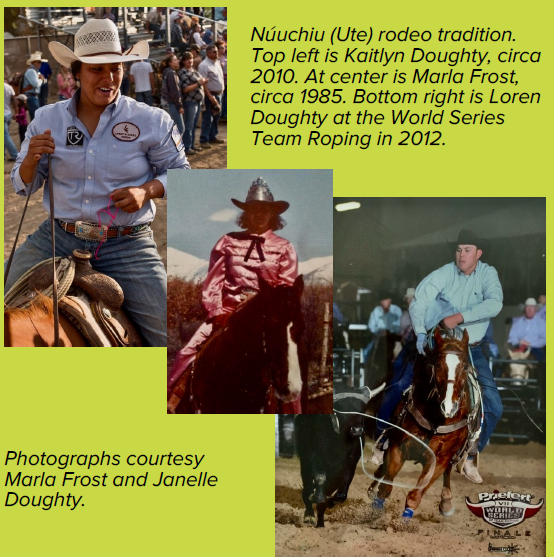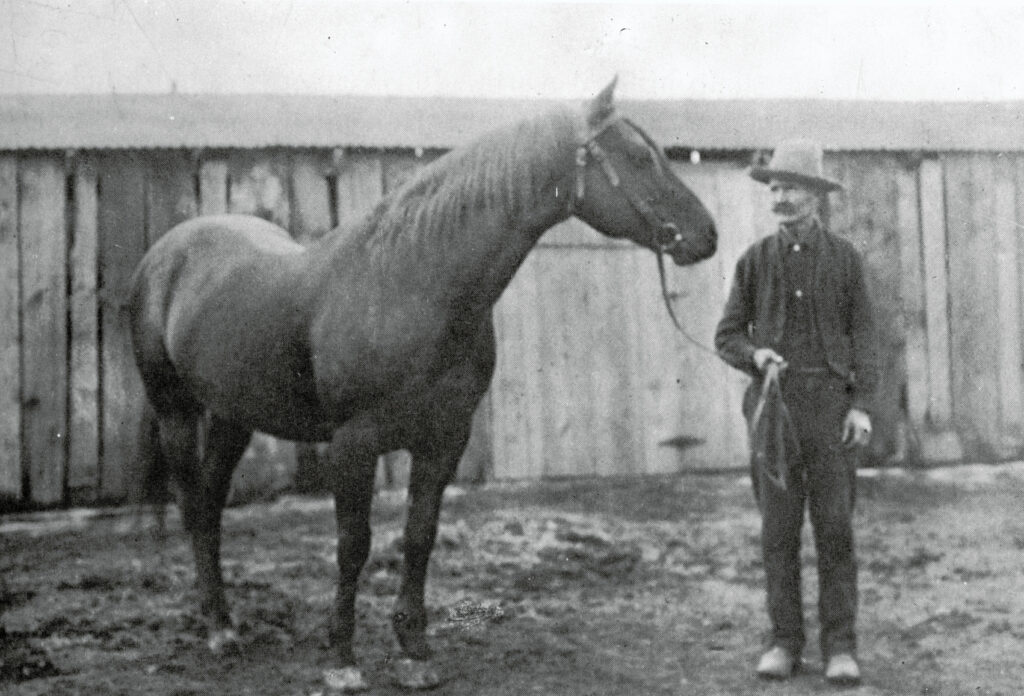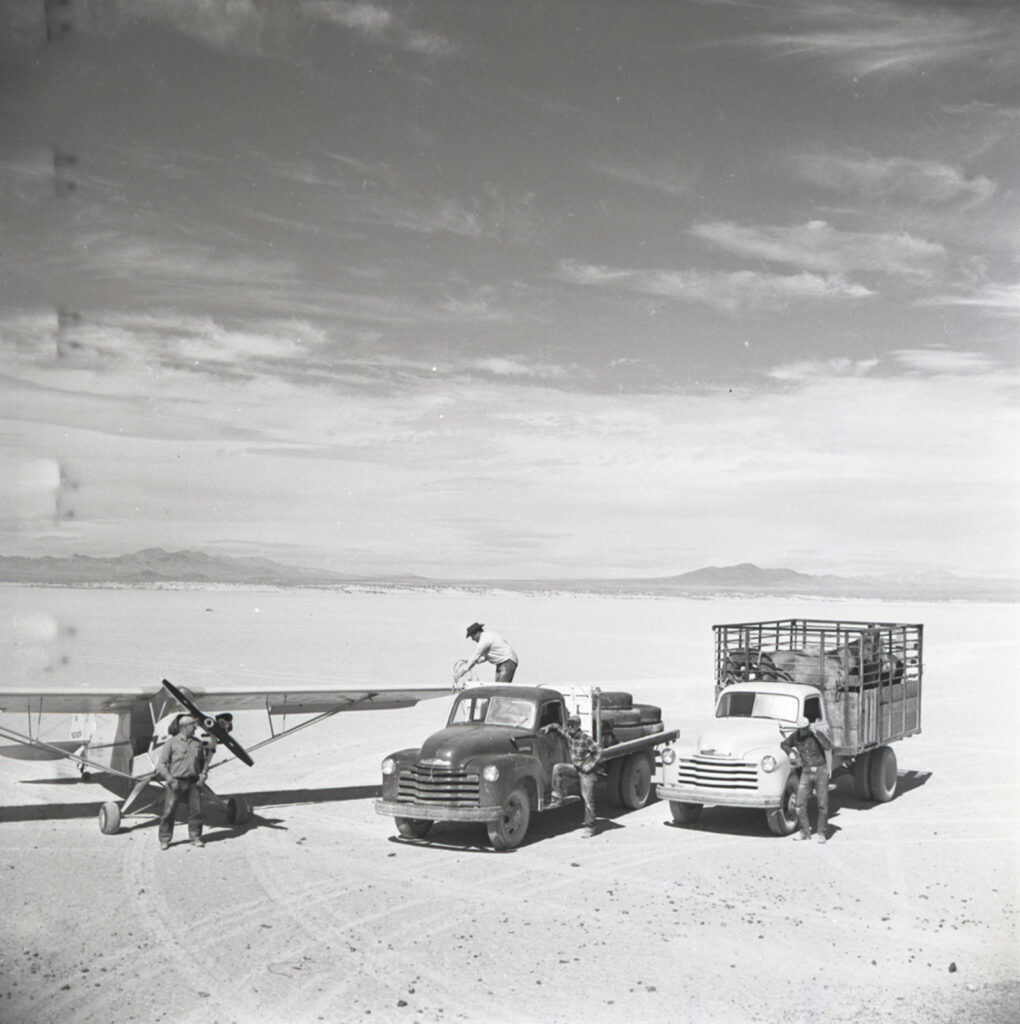By Dr. Leisl Carr Childers, Hailey Doucette, & Retta Bruegger
Quick Facts…
- Wild horses and burros are the descendants of the animals brought to North America by European colonists.
- Indigenous peoples such as the Núuchiu (Ute) in Colorado developed powerful horse cultures.
- In Colorado, federal removal of Indigenous peoples stemmed from tensions with American settlers over access to land and horses.
- By the twentieth century, horses and burros roaming free on the nation’s remaining rangelands were more valuable for their meat than their labor.
- Beginning in 1959,Congress passed laws to protect wild horses and burros on the nation’s rangelands.
Introduction
Today’s wild horses and burros are the descendants of the equines bred and brought to North America by European colonists and the subsequent horses bred and raised by Indigenous peoples and American settlers. Before mechanization, these animals were crucial to the lifeways of Indigenous peoples and American settlers, providing valuable labor, transportation, and companionship, facilitating the industrial development and western expansion of the United States. This factsheet provides an overview of the history of wild horses and burros in Colorado and the American West.
Origins in North America and Reintroduction
Just over a million years ago, North America was home to the first modern species of Equus, the family of animals called equids that includes horses (caballoids) and donkeys or asses (noncaballoids). For hundreds of thousands of years, early equids migrated widely across grasslands and steppes around the globe. But about 9,000 years ago, archaeological evidence to date suggests equids became extinct in the western hemisphere. Scientists think that a combination of climate change, disease, and predation contributed to their demise.
This has implied that the evolution of Equus in all its iterations was halted in the western hemisphere (1). But not all equids disappeared from the archeological record. In Europe and Asia, Equus continued to evolve and was genetically like the North American species of Equus (2).
In the eastern hemisphere, on the European, Asian, and African continents, wild horses, or Equus ferus, and their counterparts, wild asses such as Equus africanus, continued to thrive on arid grassy plains despite significant pressure from human hunters. Between the fourth and the second millennium BCE, most equine anthropologists and historians think that humans domesticated the wild horse and its smaller counterpart, the wild ass on the Eurasian steppes.
The domestic horse, Equus ferus caballus, and the domesticated wild ass or donkey, Equus africanus asinus, transformed human mobility (3). For several millennia, humans bred and distributed domestic horses and donkeys widely across Europe, Asia, and North African.
Christopher Columbus’s voyages to the western hemisphere brought these domestic horses and donkeys from Europe and North Africa to the Caribbean beginning in 1493.
About twenty-five years later, in 1519, the Spanish conquistador Hernando Cortés brought horses from Cubanascnan (Cuba) to Tenochtitlán (Mexico City) as part of his conquering force to the mainland. Donkeys, called burros in Spanish, served subsequent conquering forces as pack animals and provide breeding stock for mules, a hardy hybrid of the horse and donkey. As Spanish conquest expanded throughout the western hemisphere, so did equine (4).
Spanish horses and burros populated the western half of North America in the seventeenth century as Spanish conquistadores made their way north from Tenochtitlán into the arid reaches of the North American deserts. American settlers came to call the horses running wild in the region mustangs, derived from the Spanish term mesteño. Throughout their expansion, the Spanish conquerors captured and enslaved Indigenous peoples and taught them European equine traditions. Later European colonists from France, England, and elsewhere also brought horses to the colonies on the Atlantic, Gulf, and Pacific coasts, bringing similar traditions (5).
Indigenous Horse Power
In many Indigenous oral traditions, knowledge of and experience with equines predates the introduction of European horses and donkeys. Newer archaeological evidence even suggests that the North American species of Equus survived in some isolated areas and that the ancestors of some Indigenous peoples had direct experience with equines before the arrival of European colonists (6).
However, most of the continent’s Indigenous peoples secured consistent access to horses with the arrival of European colonists in the American Southwest and by the eighteenth century, horses were fundamental to the lifeways of many Indigenous peoples, particularly on the North American grasslands. The Spanish had prohibited Indigenous peoples from acquiring horses, but the 1680 Pueblo Revolution drove Spanish colonists out of Santa Fe, leaving horses behind (7).
The slow trickle of Spanish horses into Indigenous hands accelerated. By the turn of the nineteenth century, Indigenous groups such as the Núuchiu (Ute), Diné (Navajo), Nʉmʉnʉʉ (Comanche), Niimíipuu (Nez Perce), Absaroka (Crow), Tsêhéstáno (Cheyenne), and Hinono’eiteen (Arapaho) had substantial herds (8).
In the region that became Colorado, the Núuchiu (Ute), Tsêhéstáno (Cheyenne), and Hinono’eiteen (Arapaho) peoples rapidly integrated horses into their lifeways. The Núuchiu (Ute) were among the very first Indigenous peoples to acquire Spanish horses. The Núuchiu (Ute) may have captured Spanish horses as early as the 1580s, but in 1637 several captives in Santa Fe escaped and took several Spanish horses with them. Horses solidified Núuchiu (Ute) power on and control of the Colorado Plateau and central Rocky Mountains.
The Núuchiu (Ute) carefully bred and trained their horses over centuries, developing a unique horse culture that included specialty tack and riding techniques that allowed warriors to hang from the side of their horses while running and use the animals’ bodies as shields. They also developed a tradition of horse racing and gambling similar to the Thoroughbred racing seen later in the New England colonies. In the mid-nineteenth century, Núuchiu (Ute) horse races attracted crowds of gamblers, including many settlers (9).
In 1849, the Núuchiu (Ute) and the US government negotiated a treaty to ensure Americans safe passage through Núuchiu (Ute) territory in exchange for protection from attacks. This treaty ensured the US would gain access to the territory between the Rocky Mountains and the Pacific Ocean it had won in the war with Mexico. But as more and more American colonists migrated westward in the late 1800s in the wake of the California, Nevada, and Colorado gold rushes to work mines, settle and establish farms and ranching operations, they conflicted with Núuchiu (Ute) and other Indigenous peoples over land use and access to natural resources. In 1868, the US government pressured the Núuchiu (Ute) in western Colorado to sign another treaty to relinquish the Eastern Rockies to the US in exchange for the Western Slope. The US government promised the Núuchiu (Ute) regular annuities, such as food, household goods, and manufactured clothing in addition. However, the lack of adequate roads to the Los Piños and White River Indian agencies (located where Montrose and Meeker are today) and the corruption of many of the men who worked as Indian agents made it difficult for the promised annuities to reach the Núuchiu (Ute) (10).
Compounding this problem, White River Indian agent Nathan Meeker aggressively opposed Núuchiu (Ute) horse raising, training, and racing. Meeker believed, as did many Americans at the time, that the practice of gambling was immoral, and that farming was the best use of land and a person’s time. Meeker began seizing Núuchiu (Ute) horses to stop horse races and the attendant gambling and plowed under their racetrack. To prevent Meeker taking any more of their animals, in September 1879 the Núuchiu (Ute) attacked Meeker, killing him and eight of his workers. The US government retaliated, forcibly removing the Núuchiu (Ute) to reservations 1881 and again in 1882 (11).
Their removal forced the Núuchiu (Ute) to leave behind many of their horses. The descendants of these Núuchiu (Ute) horses formed the basis of Colorado’s wild horse herds on the Western Slope. But despite removal from their homelands, the Núuchiu (Ute) continued to maintain their horse culture, breeding and training horses throughout the twentieth century to the present and significantly contributed to the creation of rodeo sport (12).
Symbols of Western Settlement
The American settlers who invaded Núuchiu (Ute) lands brought a variety of equines with them such as the Thoroughbred, Arabian, Standardbred, Clydesdale, and even burros. Equines were particularly important to the development of the American West. Horses transported people, hauled freight, and plowed the ground, and burros worked the mines hauling equipment and ore. On western grasslands, cowboys rode hardy horses on cattle drives between Texas and Montana (13). Many of the region’s Indigenous peoples, including the Núuchiu (Ute), helped create this ranch culture (14). The variety of equines bred during this time reflected the variety of work Americans did. In Colorado, prominent families such as the Whipple family of Kit Carson County and the Casement family of Kansas innovated horse breeds tailored to Colorado conditions. The Whipples helped found the Colorado Ranger breed and the Casements helped found the American Quarter Horse. Both breeds utilized Indigenous horse bloodlines, worked well with cattle, had good dispositions, and could handle the Colorado climate (15).
American settlers and Indigenous peoples raised horses in the American West and Colorado largely on the region’s ranches, but they also looked to the free roaming herds for access to new breeding stock. Bands of horses roamed most of the American West from California to the Mississippi River in the nineteenth century, especially on the Great Plains, the Central Valley, and even in the drier intermountain region. These free-roaming bands provided horses for anyone who could catch them. “Mustanging,” the term given to rounding up wild horses, was a favorite pastime for bored and unemployed cowboys who used them for mounts and bucking competitions in early rodeos. Roundups of wild horses also provided income for mustangers who sold them for meat or to the US Army who valued their extraordinary stamina. The numbers of wild horses, and also burros, tended to increase in poor economic times when people could not maintain their ranches and turned their animals loose to survive on their own (16).
In Colorado, wild horse herds on the Western Slope that had begun with Núuchiu(Ute) horses, evolved as additional horses from American settlers, many with pedigreed European bloodlines, populated the herds.
On the Uncompahgre Plateau and throughout the canyons along the Dolores River, the horses that now roam the Spring Creek Basin Herd Management Area are the descendants of Núuchiu (Ute) horses and horses from ranches in Montana brought to Disappointment Valley by a thief known only as “Morgan.” In the Grand Valley, on the Roan Plateau, and along the Little Snake River, the horses that populate the Little Book Cliffs Wild Horse Range, the Piceance-East Douglas and Sand Wash Basin herd management areas descended from Núuchiu (Ute) horses and horses loosed from local ranches. In each of these regions, local ranchers managed wild horse herds by capturing horses to train for work and by introducing new horses to those wild herds with particular characteristics they hoped to breed into future foals (17).
By the turn of the twentieth century, however, the American West had changed. The West was industrialized and modernized.
Reliance on horses and burros shifted to mechanized transportation such as the automobile. Popular American writers and performers memorialized the elements that Americans believed had constituted the western frontier —Indian warriors, cowboys and ranchers, gold miners and gunfighters—in sensational stories and public performances. This western genre developed in novels by authors such as Zane Grey and in live performances by Buffalo Bill’s Wild West Show that featured spectacles of Indigenous horsemanship and mock historical battles between Indians and the US Army. In this western popular culture, audiences connected untamed, wild horses to ideas of the western frontier, open space, and even freedom itself (18).
Protections for Wild Horses
At the same time many Americans began to mythologize wild equines, three changes occurred that jeopardized their presence on western rangelands. The first change was the organization of unsettled rangelands under the US government. With the creation of the Forest Service in 1905 and the Grazing Service in 1934 (which became the Bureau of Land Management (BLM) in 1946), the federal government took on the responsibility for organizing ranchers who raised livestock on its lands and managing grazing resources, including those on tribal lands (19).
The government began limiting the number of ranchers who could use public rangelands and the number of livestock allowed on the range, and started charging ranchers for the use of grazing resources on public lands in an effort to reduce overuse (20). Wild horses and burros competed with privately-owned livestock for the same grazing resources. This competition had always been there, but it mattered less when grazing on public rangelands was free (21).
The second change was the emergence of the pet food industry. During the agricultural depressions that followed both world wars, ranchers let many horses they could not feed loose onto public rangelands. Mustangers found ample opportunity rounding up wild horses and burros and selling them not only for meat for human consumption, which was desperately needed during these economic crises, but also to pet food processors. The new pet food industry organized around suburban middle-class American families who owned dogs and cats. Rather than feed them messy table scraps, these pet owners bought tidy, easily stored canned and dried pet food made from horse meat. This industry created huge demand for cheap meat (22).
The final change was the use of mechanized vehicles and aircraft in rounding up wild horses and burros. Trucks and airplanes made spotting and moving wild horses and burros much faster and less dangerous for mustangers chasing them at full speed on horseback. However, the speed at which trucks and airplanes pursued wild horses and burros caused panic in the animals and often led to fatal injuries. The increased efficiency these new technologies brought to roundups meant more and more wild horses and burros were going to slaughterhouses. By the 1950s, it seemed to many Americans that wild horses and burros might disappear from public lands (23).
Protections for wild horses and burros emerged out of fears that these equines would be eliminated from public rangelands of the American West and from disgust at the damage done to them by mechanized roundups. In Nevada, where most wild horses roamed, Velma Bronn Johnston, a rancher’s daughter who had grown up near Reno and was known as Wild Horse Annie, advocated for the protection of wild horses after witnessing appalling injuries created by mechanized roundups.
She helped create the first wild horse protection law in Nevada in 1955, pushed for a national ban on mechanized roundups in 1959, and helped secure federal protection for wild horses and burros in 1971 with the Wild Free-Roaming Horse and Burro Act (24)
Since 1971, the BLM, and to a lesser degree the Forest Service, have assumed responsibility for the management of wild horses and burros on federal lands. Likewise, Indigenous tribal governments oversee protections of these animals on their sovereign lands, though most Indigenous groups do not treat them as animals to be managed but rather as relatives who can manage themselves (25). Subsequent federal laws have added further protective measures and prescribed how federal agencies manage wild horses and burros. In 1976, the Federal Land Policy and Management Act (FLPMA) permitted the use of helicopters, which move slower than airplanes but are more efficient than ground vehicles in gathering wild horses and burros. The Public Rangelands Improvement Act (PRIA) of 1978 required the BLM to inventory and improve rangeland resources for all the animals that rely on them, including wildlife, livestock, and wild horses and burros, and allowed for the removal of wild horse and burro populations that the BLM deemed to be more than what those resources can support. In addition, several court cases have ensured that the federal government can regulate and protect wild horses and burros and that wild horses and burros cannot be sold to meat packing houses for slaughter and use in the pet food industry. Similarly, tribal governments determine the parameters of management practices towards wild horses and burros on the lands they oversee (26).
In Colorado, the BLM manages wild horses at Spring Creek Basin, Sand Wash Basin, and Piceance-East Douglas herd management areas and the Little Book Cliffs Wild Horse Range herd management area. The agency often works with volunteer groups such as the Friends of the Mustang in Grand Junction and the Piceance Mustangs group in Meeker to help with this management (27).
The Wild Horses and Burros Adoption program, created by the 1971 protection act, seeks to find private homes for wild horses and burros taken off public rangelands. But the BLM and tribal governments remove more wild horses and burros each year than are adopted by private owners. Those equines not adopted are held in long-term pastures funded by the BLM, which is expensive and controversial because the animals are no longer free roaming. The factsheet, “An Overview of Wild Horse and Burro Management in the American West,” explains this further.
Conclusion
Today, wild horses and burros are protected. These animals are the descendants of the equines of Indigenous peoples, Spanish conquerors, and those American settlers brought to the American West. In Colorado, the BLM oversees three wild horse herd areas and one wild horse range in the Núuchiu (Ute) homelands in the Western part of the state. To Indigenous peoples, wild horses are reminders of their own past as powerful horse nations. To many advocates, wild horses and burros symbolize the western frontier and the process of American settlement. The successful passage of the federal law and tribal government protections for these equines is evidence of many Americans’ commitment to their preservation as symbols of the past, but their management is controversial. Ranchers and wildlife managers are concerned about the impacts that excessive numbers of wild horses and burros have on public rangelands. Advocacy groups want to ensure wild horse and burro numbers remain high. The federal agencies that manage wild horses and burros, the BLM and the Forest Service, are faced with the difficult task of balancing wild horse and burro populations with other multiple uses of public rangelands.
Citations
1. Pita Kelenka, The Horse in Human History (New York: Cambridge University Press, 2013), 10-11, 16-18, 22-24; Charles Mann, 1491: New Revelations of the America’s Before Columbus (New York: Vintage, 2006), 17-23.
2. Jay F. Kirkpatrick, Patricia M. Fazio, “The Surprising History of America’s Wild Horses,” Live Science, July 24, 2008, https://www.livescience.com/9589- surprising-history-america-wild-horses.html;
3. Ann Forsten, “Equus lambei Hay, the Yukon Wild Horse, Not Ass,” Journal of Mammalogy, vol. 67, no. 2 (May 1986): 422-423; Charles Vila, et. al., “Widespread Origins of Domestic Horse Lineages,” Science, vol. 291, no. 5503 (January 19, 2001): 474-477.
4. Kelenka, The Horse in Human History, 29-44.
5.John J. Johnson, “The Introduction of the Horse into the Western Hemisphere,” The Hispanic American Historical Review 23, no. 4 (1943): 588-606; Clive Roots, Domestication (West Port, CT: Greenwood Press, 2007), 178-181.
6. Robert Denhardt, “The Horse in New Spain and the Borderlands,” Agricultural History, vol. 25, no. 4 (1951): 145-150.
7. Yvette Running Horse Collin, “The Relationship Between the Indigenous Peoples of the Americas and the Horse: Deconstructing a Eurocentric Myth,” Dissertation, University of Alaska Fairbanks, May 2017, 111; Vine Deloria, Jr., Red Earth, White Lies: Native Americans and the Myth of Scientific Fact (New York: Scribner, Inc., 1995).
8. Andrés Reséndez, The Other Slavery: The
Uncovered Story of Indian Enslavement in America (Boston: Mariner Books, 2017), 175. The term “lifeway” refers to the integrated way Indigenous cultures experience social, economic, and spiritual aspects of life. See Winona LaDuke, “Minobimaatisiiwin: The Good Life,” Cultural Survival Quarterly 16, no. 4 (winter 1992): 69–71 and Winona LaDuke, All Our Relations: Native Struggles for Land and Life (Cambridge, Mass.: South End Press, 1994) 4, 132.
9. Pekka Hämäläinen, “The Rise and Fall of Plains Indian Horse Cultures,” Journal of American History, vol. 90, no. 3 (2003): 833-862.
10.“Early History,” Southern Ute Website,
https://www.southernute-nsn.gov/history/; “Ute History and the Ute Mountain Tribe,” Lynn Brittner, “The People of the Horse: The Essential Role of the Horse Has Stood the Test of Time for the Utes,” True West: History of the American Frontier, July 10, 2012 (https://truewestmagazine.com/the-people-of-the horse/); Brandi Denison, Ute Land Religion in the American West, 1879-2009 (Lincoln: University of Nebraska Press, 2017), 31-32. Also see Sondra G. Jones, Being and Becoming Ute: The Story of an American Indian People (Salt Lake City: University of Utah Press, 2019 and Virginia McConnell Simmons, The Ute Indians of Utah, Colorado, and New Mexico (Boulder: University Press of Colorado, 2001).
11. Peter Decker, The Ute’s Must Go: American Expansion and Removal of a People (Golden:
Colorado, Fulcrum Publishing, 2004), 173-194; Robert Silbernagel, Troubled Trails: The Meeker Affair and the Expulsion of the Utes from Colorado (Glen Canyon: Utah, University of Utah Press, 2011), 49-62.
12. Decker, The Ute’s Must Go, 173-194; Silbernagel, Troubled Trails, 49-62.
8
13. Shannon Mullane, “Southern Ute Tribe to Celebrate Its History at Tribal Fair This Weekend,” The Journal, September 12, 2019, https://the journal.com/articles/151989. Also see the exhibit at the Southern Ute Culture Center and Museum entitled “Riders of the West: Portraits from Indian Rodeo,” Southern Ute Culture Center and Museum Website (https://www.southernutemuseum.org/event/riders-of the-west-portraits-from-indian-rodeo/) and Peter Iverson, Riders of the West: Portraits from Indian Rodeo (Seattle: University of Washington Press, 1999).
14. Terry G. Jordan, North American Cattle-Ranching Frontiers: Origins, Diffusion, and Differentiation (Albuquerque: University of New Mexico Press, 1993).
15. Peter Iverson, When Indians Became Cowboys: Native Peoples and Cattle Ranching in the American West (Norman: University of Oklahoma Press, 1997).
16. Ann Norton Greene, Horses at Work: Harnessing Power in Industrial America (Cambridge, MA; Harvard University Press, 208), 164-166; “CRHA History,” Colorado Ranger Horse Association Website, http://www.coloradoranger.com/history.html; “The History of the American Quarter Horse Breed,” American Quarter Horse Association Website, https://www.aqha.com/history-of-the-quarter-horse.
17. Leisl Carr Childers, The Size of the Risk: Histories of Multiple Use in the Great Basin (Norman: University of Oklahoma Press, 2015), 154-158.
18. Montrose District, “Gather and Capture Plan for the Naturita/Spring Creek Basin Wild Horse Herds,” Bureau of Land Management, circa 1985, 3-4; Grand Junction District, “Little Bookcliffs wild Horse Management Plan,” Bureau of Land Management, June 8, 1992, 2-3.
19. Dave Philipps, Wild Horse Country: The History, Myth, and Future of the Mustang (New York: W.W. Norton & Company Inc., 2017), 104-128; Deanne Stillman, Mustang: The Saga of the Wild Horse in the American West (New York, New York: Houghton Mifflin Company, 2008), 127-160.
20. Karen R. Merrill, Public Lands and Political Meaning: Ranchers, the Government, and the Property Between Them (Berkeley: University of California Press, 2002), 135-162; Marsha Weisiger, Dreaming of Sheep in Navajo Country (Seattle: University of Washington Press, 2011), 188-189.
21. Nathan F. Sayre, The Politics of Scale: A History of Rangeland Science (Chicago: University of Chicago Press, 2017), 114-132.
22. Carr Childers, The Size of the Risk, 160-161.
23. Carr Childers, The Size of the Risk, 163-165; Philipps, Wild Horse Country, 60-103.
24. Carr Childers, The Size of the Risk, 163-164
25. Alan Kania, Wild Horse Annie: Velma Johnston and her Fight to Save the Mustang (Reno, Nevada: University of Nevada Press, 2012), 7-51; Wild Free
Roaming Horses and Burros Act of 1971 (Public Law 92-195) s. 1331,
https://www.blm.gov/or/regulations/files/whbact_1971. pdf.
26. Running Horse Collin, “The Relationship Between the Indigenous Peoples of the Americas and the Horse,” iv. The term “relative” refers to the ways in Indigenous peoples traditionally have viewed horses and other animals as “beings” and “sacred relatives,” rather than dumb beasts.
27. BLM Library, “Wild Horses and Burros Subject Guide – Policy and Legal Resources,” Bureau of Management Website, https://www.blm.gov/learn/blm library/subject-guides/wild-horse-and-burro-subject guide/policy-and-legal-resources; “Rep. Chris Stewart Introduces Bill Giving States the Ability to Manage Wild Horses and Burros,” July 10, 2014, US Congressman Chris Stewart Website
(https://stewart.house.gov/news/documentsingle.aspx ?DocumentID=250); “Bill Allows Tribe to Manage Wild Horse Herds from Federal Land,” July 15, 2014, IndianZ.com,
https://www.indianz.com/News/2014/014394.asp. For more information about the herd areas and ranges in Colorado, see Colorado Herd Management Areas, Bureau of Land Management Website, https://www.blm.gov/programs/wild-horse-and burro/herd-management/herd-management areas/colorado.
L. Carr Childers, Associate Professor, Department of History, Colorado State University
H. Doucette, Master of Arts Program, Department of History, Colorado State University
R. Bruegger, Regional Range Specialist for Western Colorado, CSU Extension.
Colorado State University, U.S. Department of Agriculture and Colorado counties cooperating. CSU Extension programs are available to all without discrimination. No endorsement of products mentioned is intended nor is criticism implied of products not mentioned.


